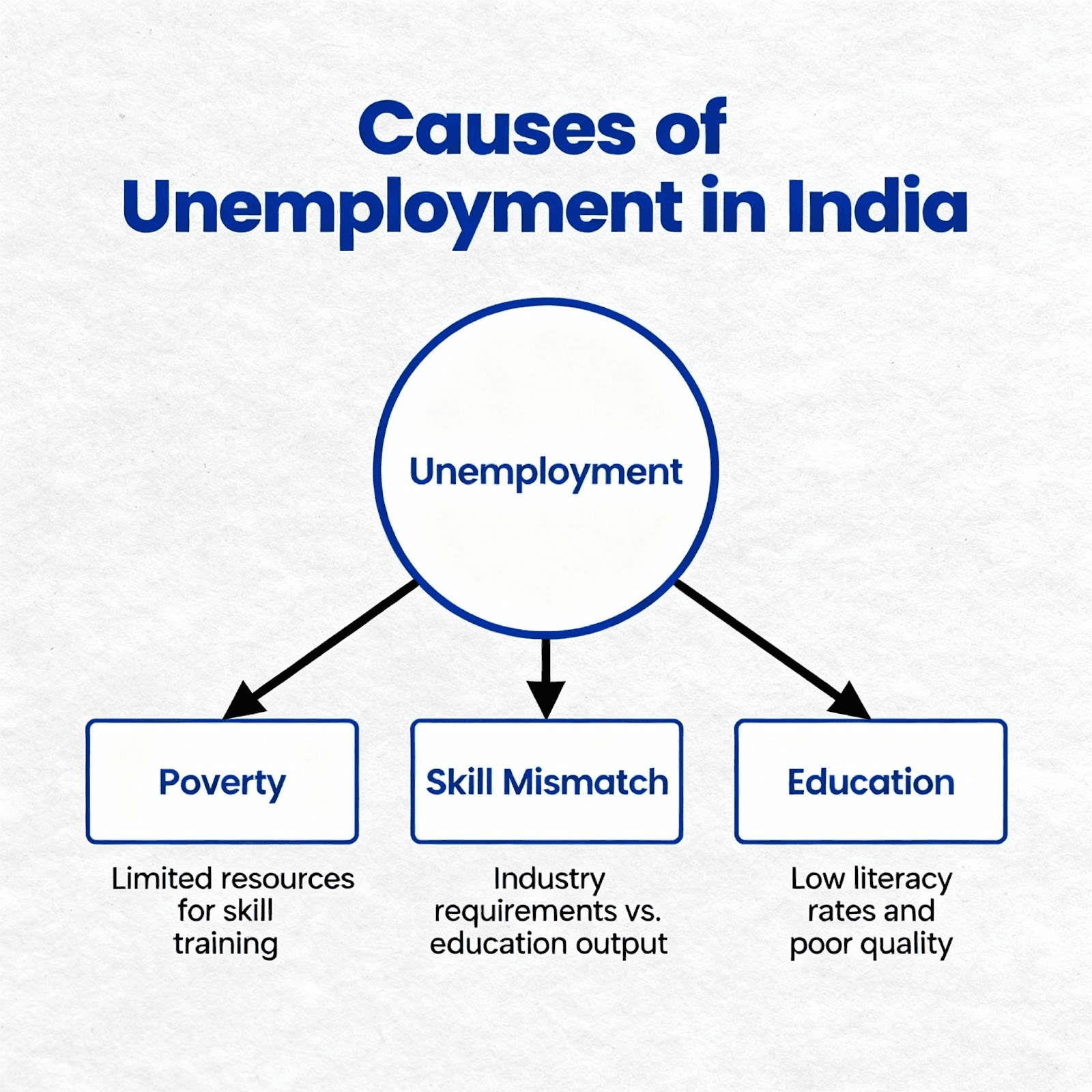Unemployment in India UPSC Notes: Types, Causes & Government Measures
Oct, 2025
•5 min read
Unemployment refers to the condition where individuals who are capable of working and actively seeking employment are unable to find a job. It indicates the health of an economy and represents the underutilization of human resources. It is calculated as:
Key Facts about Unemployment in India:
- India's unemployment rate declined from 6.0% in 2017-18 to 3.2% in 2023-24.
- Employment in India rose to 64.33 crore in 2023-24 from 47.5 crore in 2017-18, adding 16.83 crore jobs over six years.
- Urban unemployment (6.5%) remains higher than rural unemployment (4.5%) (PLFS, MoSPI).
- Female Labour Force Participation Rate rises to 33.7% in August 2025 from 33.3% in July 2025 and 32.0% in June 2025.
- The PM Viksit Bharat Rozgar Yojana aims to create more than 3.5 crore jobs over a period of 2 years, with an outlay of Rs 99,446 crore.
Key Causes of Unemployment in India
Understanding the root causes of unemployment is crucial for developing effective solutions and policy interventions. Let's understand!

- Rapid population growth leads to more job seekers than available jobs.
- Slow industrial growth limits the creation of formal jobs.
- Seasonal agriculture creates employment only during certain periods.
- Informal sector dominance causes job insecurity and low wages.
- The education system is failing to provide the skills needed for emerging industries.
- Technology and automation are changing job requirements quickly.
- Socio-economic factors, including caste discrimination, gender barriers, and limited access to resources.
Also cover this key syllabus topic: 2nd ARC Report UPSC Mains: Key Recommendations & Summary
Types of Unemployment
India faces multiple forms of unemployment, each with distinct characteristics that reflect the country's diverse economic structure.
1. Disguised Unemployment:
- More people are employed than are actually needed for productive work.
- Primarily found in agricultural and unorganised sectors.
- Workers contribute little to no additional productivity.
- Common in family-run businesses and traditional farming.
2. Structural Unemployment:
- Results from a mismatch between available job skills and market requirements.
- Caused by changes in the economy and technological advancement.
- Affects workers whose skills become obsolete due to technological progress.
- Particularly impacts manufacturing workers due to automation.
3. Seasonal Unemployment:
- Occurs during specific seasons when demand for certain types of work decreases.
- Agricultural labourers often experience a lack of work throughout the year.
- Tourism and hospitality sectors face seasonal variations.
- Affects workers in weather-dependent industries.
4. Cyclical Unemployment:
- Result of business cycles where unemployment rises during recessions.
- Businesses lay off workers during economic downturns.
- Workers are rehired during recovery phases.
- Less significant in India compared to developed capitalist economies.
5. Frictional Unemployment:
- Temporary unemployment during job transitions.
- Time lag between leaving one job and finding another.
- Often voluntary as workers seek better opportunities.
- Natural part of a dynamic labour market.
6. Vulnerable Employment:
- People are working informally without proper job contracts.
- No legal protection or documented work records.
- One of the main types of unemployment in India.
- Affects millions in the informal sector.
How is Unemployment Measured in India?
India uses different surveys to measure unemployment, each looking at joblessness over different time periods and for different groups of people.
- Usual Status (US): Assesses activity over a long reference period (365 days), identifying persons usually employed or unemployed.
- Current Weekly Status (CWS): Captures work status during the seven days preceding the survey, distinguishing employed, unemployed, and outside labour force.
- Current Daily Status (CDS): Records work undertaken each day of the reference week, measuring day-to-day fluctuations in employment.
- Periodic Labour Force Survey (PLFS): Provides continuous quarterly estimates using a rotating panel design, emphasising CWS for timely labour market indicators.
- ILO's Labour Force Definition: Aligns with international standards, persons without work, available for work, and actively seeking employment, used broadly for comparability.
You might also like: GST 2.0 Reforms in 2025: UPSC Syllabus Relevance & Notes
State-wise Unemployment Rate in India: Latest Data
State-wise unemployment data provides crucial insights into regional employment challenges and helps understand the diverse economic landscape across India's states and union territories.
Top 5 States with Highest Unemployment (Jan–Mar 2024, All-India, Persons):
- Kerala: 10.7%
- Jammu & Kashmir: 11.0%
- Rajasthan: 9.6%
- Himachal Pradesh: 9.1%
- Telangana: 8.8%
Top 5 States with Lowest Unemployment (Jan–Mar 2024, All-India, Persons):
- Assam: 6.1%
- West Bengal: 5.2%
- Gujarat: 4.6%
- Delhi: 1.8%
- Madhya Pradesh: 5.4%
How the Government is Combating Unemployment in India
The Government of India has implemented many schemes and policies to tackle unemployment through direct employment generation and skill development initiatives. Here are the major employment generation schemes:
1. Mahatma Gandhi National Rural Employment Guarantee Act (MGNREGA):
- Provides 100 days of guaranteed wage employment to rural households.
- Focuses on creating durable assets in rural areas.
- Includes skill development components for transitioning to skilled labour.
- Reduces dependency on seasonal employment and migration.
2. Prime Minister's Employment Generation Programme (PMEGP):
- Credit-linked subsidy scheme for establishing micro-enterprises.
- Provides 15-35% subsidy on project cost depending on category and location.
- Maximum project cost: ₹50 lakh for manufacturing, ₹20 lakh for services.
- Implemented by Khadi and Village Industries Commission (KVIC).
- Targets both rural and urban areas for employment generation.
3. Pradhan Mantri Kaushal Vikas Yojana (PMKVY):
- Provides short-term training and certification in various skills.
- Focuses on employability and entrepreneurship development.
- Industry-aligned skill training programs.
4. Deen Dayal Upadhyaya Grameen Kaushalya Yojana (DDU-GKY):
- Targets rural youth from poor families.
- Provides training and placement opportunities.
- Aims to enhance employability in formal sector jobs.
Must read: Prime Minister Dhan-Dhaanya Krishi Yojana
UPSC Mains Practice Question on Unemployment
Unemployment remains a persistent challenge in India despite strong economic growth in recent years. Examine the causes and types of unemployment in India and suggest measures the government can adopt to effectively reduce it.
Evaluate for Free!Way Forward
A mix of immediate job schemes and long-term reforms can sustainably lower unemployment.
- Scale up vocational training tied to industry needs.
- Incentivise labour-rich manufacturing and MSMEs.
- Diversify rural incomes via agro-industries and digital services.
- Enable women’s work through childcare support and flexible jobs.
- Use real-time PLFS data to fine-tune policies.
UPSC Prelims PYQs on Unemployment
QUESTION 1
Medium
Disguised unemployment generally means:
Select an option to attempt
Crack UPSC Confidently with SuperKalam!
SuperKalam is your 24x7 personal AI mentor for UPSC preparation that provides:
- Instant Doubt Resolution
- Instant Mains Answer Evaluation for GS, Ethics & Essay
- Unlimited MCQ Practice on any topic/subject
- PYQ Practice for Prelims
Start with free trial access today to experience the magic!


![PM MUDRA Yojana 2025: Shishu to Tarun [UPSC Notes]](/_next/image?url=https%3A%2F%2Fblog-media.superkalam.com%2FPM_Mudra_Yojana_e5ffe37cf1.jpeg&w=3840&q=75)
